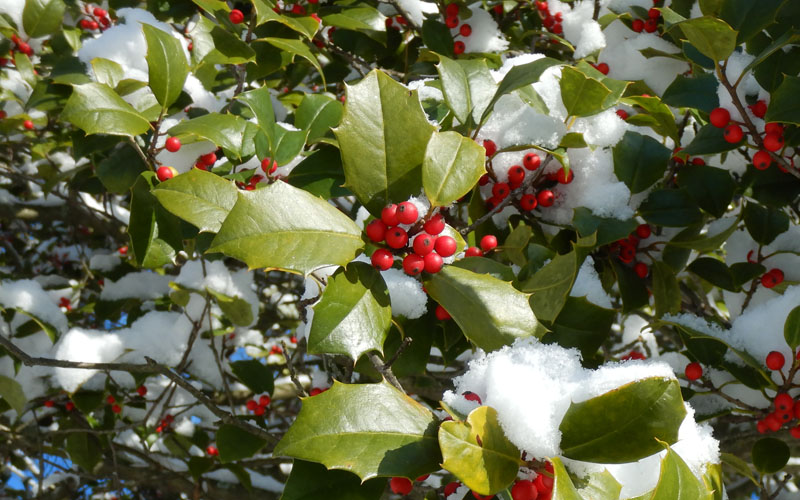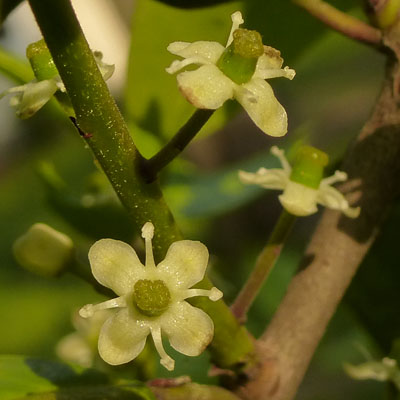Home Resources Gardener News reprints: Holly: Deck The Halls
This article by Hubert Ling (NPSNJ horticulture) was published in Gardener's News without the photos. He is a regular contributing writer to Gardener's News. Photos by H & M Ling.
Deck The Halls

It’s time again to deck the halls with boughs of holly. When the Pilgrims landed in 1620, during Christmas, they were greeted by the American holly, Ilex opaca, which is very similar to the European holly. Holly has been used for centuries to celebrate Christmas: the thorns remind us of Christ’s crown of thorns and the bright red berries represent His shed blood. Because of its decorative uses American holly has been very popular since the time of European settlement. George Washington loved this tree; more than a dozen of those that he planted are still flourishing.
Holly is pollution resistant, is slow growing and rarely exceeds 30’ in cultivation. This evergreen is long lasting with contrasting persistent berries, and has a conical shape. The tallest known wild holly tree, which reaches 99 feet, is in South Carolina. Holly is moderately resistant to drought, floods, deer, and disease but has occasional minor problems with red mites, leafminers, and scale.
About 1,000 cultivars of this very popular plant have been developed and residents of Northern NJ are sometimes surprised to find that holly is also a common, wild, native understory tree of the NJ Pinelands.
Holly can be propagated by seed but germination is a problem; germination times are 16-48 months. Some suggest simply planting the seeds as soon as they turn red and others suggest a 1 hour soak in concentrated acid or scarification prior to planting to hasten germination. Holly can also be propagated by cuttings. Success is generally good especially when a rooting hormone (IBA) is used.
 See more photos and information
See more photos and information
American holly is found naturally in the US from coastal MA to FL (zones 5-9) growing in sandy, moist, acid soil in full sun or partial shade. However, it also does well in a variety of growing conditions but is not very tolerant of fire, high wind, or salt spray. This small tree has small white-greenish flowers in NJ in late May and early June which are an important food source for wasps, ants, moths, and bees; holly nectar makes an excellent honey. Male and female flowers are borne on separate trees so you need a female tree to get the red “berries” and a male tree must be nearby.
American holly is an ecologically significant plant: in NJ American holly are the principal host for the larvae of Henry’s Elfin butterfly. The berries are also an emergency food for deer, squirrels, and birds including doves, turkeys, and many songbirds. Flocks of robins, goldfinch, and cedar waxwings can completely strip a tree of all its berries in seconds. In years with mild winters the fruits persist into spring.
Holly trees retain their leaves for 3 years and the foliage is very thick; Birds frequently use holly as a secure, protected nesting site. Most animals avoid the sharp needles of the leaves but during harsh winters deer have been known to browse the foliage.
Because of the toxic properties of the berries Native Americans used holly as a strong laxative, emetic, and diuretic (your body really needs to get rid of it). Tea from the leaves was used externally for sores and itchy skin. Holly berries can be very dangerous to small children and ingesting only a few berries can lead to violent vomiting.
Holly wood is fine-textured, dense, and stable. It therefore is useful for engraving blocks, cabinet work, carvings, handles, and rulers. It can be stained black and is used to replace ebony. Holly is one of the whitest known wood and it still remains very pale after being varnished and after aging. In this regard it is very useful for creating light colored areas in the art of marquetry where beautiful pictures are “painted” with pieces of veneer.
The American holly is small enough to fit in almost every garden. It will grace your yard 365 days a year. Most people consider holly to be a fine asset even though they may release an “expletive deleted” when pricked by the leaves. Those of you in Northern NJ can find American holly flourishing at Rutgers’ Cook Gardens and at Sandy Hook.